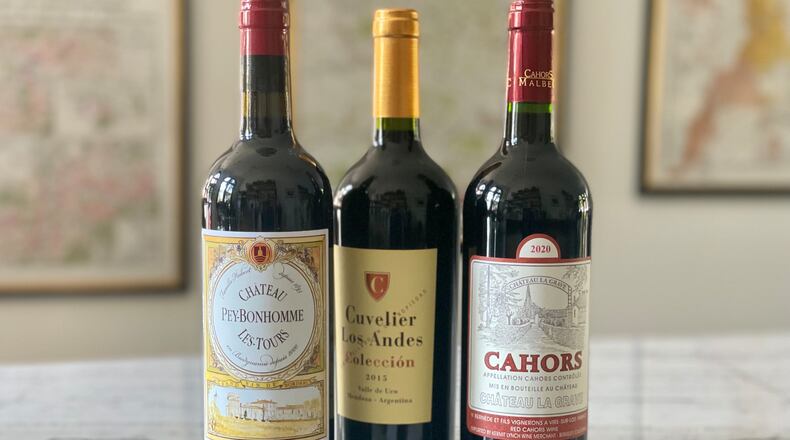When you think of malbec, you probably think of a big, fruit-forward red wine, a perfect pairing for a grilled burger or steak. You also are likely to think of Argentina, where the grape has thrived in its sunny climate for more than a century. That country now is the world’s largest producer of malbec-based wines.
But, the grape has deep roots in France, where it has played a role in winemaking since the Roman Empire. It was, in fact, a French botanist who first brought malbec grapes to Argentina in 1868.
Bordeaux is the most prestigious wine region in France where malbec is found, but it plays a mostly minor role there these days. Bordeaux is a land of blended wines, where the philosophy is that the sum is always more important than the individual parts, and blending allows for tweaks during difficult growing years.
Centuries ago, malbec was more widely planted in the region, but it suffered greatly from the phylloxera insect epidemic of the late 19th century, as well as major frosts in the mid-20th century, and was overshadowed and outplanted by merlot and cabernet sauvignon.
About 100 miles east of Bordeaux is Cahors, an ancient wine-growing region that is the rare spot in France where we find malbec (aka cot there) as the dominant grape. The iron-rich soil produces intense, inky versions, with notes of anise, violets and dark fruit.
As the weather cools, and we begin to think about meals of roasted meats and root vegetable stews, we love the complex, earthy French reds made from malbec.
Here are three of our favorite malbec wines that you can find in town, all for $25 or less:
Château Peybonhomme Les Tours Côtes de Blaye Bordeaux 2019. While it is only 10% malbec, we do think this is an outstanding wine for fall flavors, and an outstanding value for Bordeaux. Organic and biodynamically farmed since 2000, this wine is a complex blend of blackberry, plum and currant, with a lovely element of clove spice and dried leaves. Tasting Bordeaux next to Cahors is a fun study in grape and terroir; see if you can find the malbec tones in the blend.
Chateau La Grave Cahors 2020. While it is hard for us to pick our favorite wine from Cahors (there are so many great ones), this is perhaps the best for the money.
Cuvelier Los Andes malbec Valle de Uco. This is a curveball, as this is an Argentine malbec, but one made by a Bordeaux family. We’re longtime fans of these wines, which combine French winemaking techniques with the special terroir of Mendoza, Argentina. The Cuvelier family owns the Chateau Léoville-Poyferré estate in Bordeaux, and began its project in Argentina in 1998. This wine is 100% malbec, but they also make several blended wines that put malbec in the majority, with cabernet sauvignon and merlot in supporting roles.
The Slaters are beverage industry veterans and the proprietors of the Expat and the Lark Winespace in Athens.
Sign up for the AJC Food and Dining Newsletter
Read more stories like this by liking Atlanta Restaurant Scene on Facebook, following @ATLDiningNews on Twitter and @ajcdining on Instagram.
About the Author
The Latest
Featured


